Page 9 of 37
2. Basic High Voltage Information
2-1
High Voltage-Related and 12V-Related Component Locations and
Descriptions =
76
342 8
5 1
Underside View Shown
AAYIA0051GB
9
Page 10 of 37
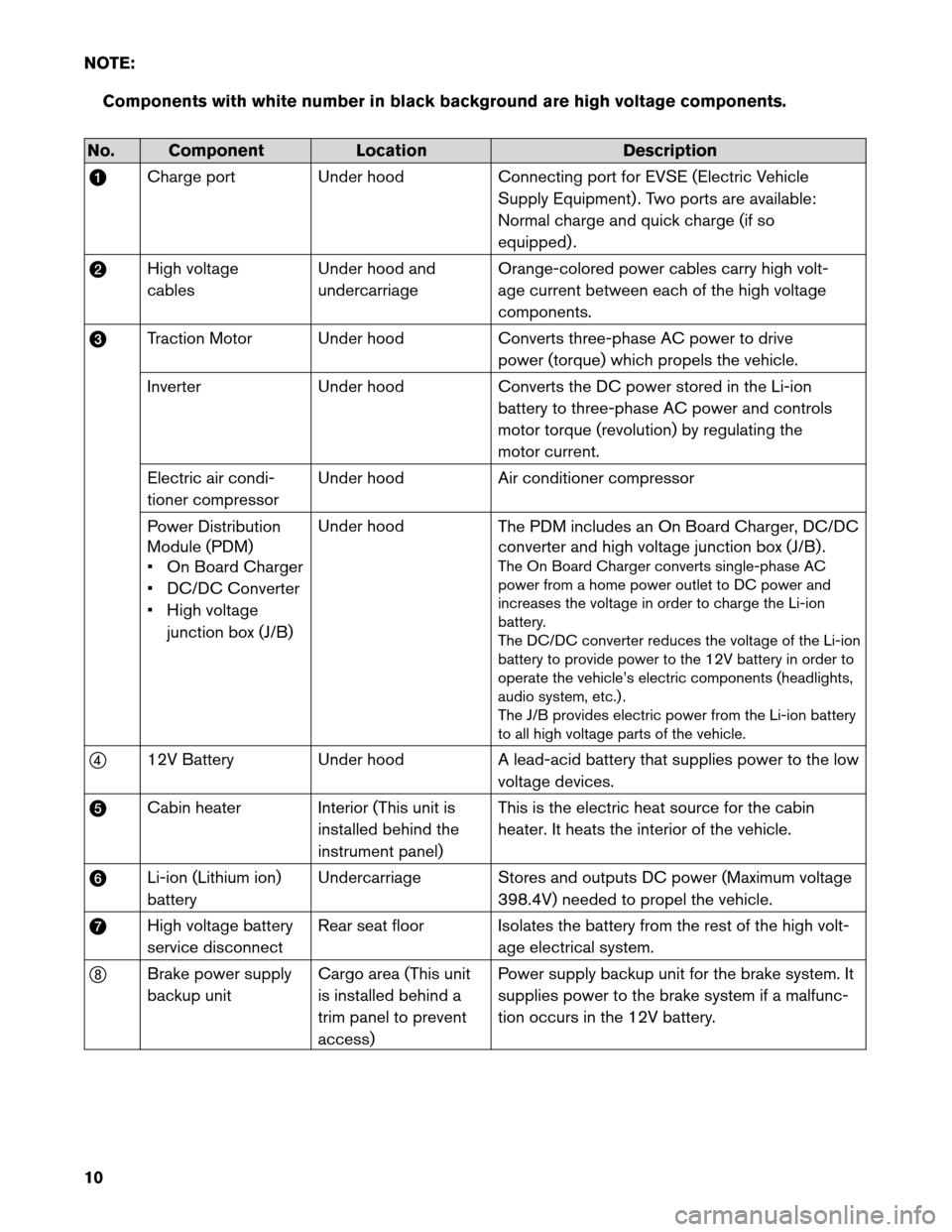
NOTE:
Components with white number in black background are high voltage components.No. Component
LocationDescription
a Charge
port Under hood Connecting port for EVSE (Electric Vehicle
Supply Equipment) . Two ports are available:
Normal charge and quick charge (if so
equipped) .
b High voltage
cables Under hood and
undercarriage Orange-colored power cables carry high volt-
age current between each of the high voltage
components.
c Traction Motor Under hood Converts three-phase AC power to drive
power (torque) which propels the vehicle.
Inverter Under hood Converts the DC power stored in the Li-ion
battery to three-phase AC power and controls
motor torque (revolution) by regulating the
motor current.
Electric air condi-
tioner compressor Under hood
Air conditioner compressor
Power Distribution
Module (PDM)
• On Board Charger
• DC/DC Converter
• High voltage junction box (J/B) Under hood
The PDM includes an On Board Charger, DC/DC
converter and high voltage junction box (J/B) .
The On Board Charger converts single-phase AC
power from a home power outlet to DC power and
increases the voltage in order to charge the Li-ion
battery.
The DC/DC converter reduces the voltage of the Li-ion
battery to provide power to the 12V battery in order to
operate the vehicle’s electric components (headlights,
audio system, etc.) .
The J/B provides electric power from the Li-ion battery
to all high voltage parts of the vehicle.
d 12V Battery Under hood A lead-acid battery that supplies power to the low
voltage devices.
e Cabin heater Interior (This unit is
installed behind the
instrument panel) This is the electric heat source for the cabin
heater. It heats the interior of the vehicle.
f Li-ion (Lithium ion)
battery Undercarriage Stores and outputs DC power (Maximum voltage
398.4V) needed to propel the vehicle.
g High voltage battery
service disconnect Rear seat floor Isolates the battery from the rest of the high volt-
age electrical system.
h Brake power supply
backup unit Cargo area (This unit
is installed behind a
trim panel to prevent
access) Power supply backup unit for the brake system. It
supplies power to the brake system if a malfunc-
tion occurs in the 12V battery.
10
Page 11 of 37
2-1.1 Li-ion Battery Pack Specifications
Li-ion battery voltage
360V nominal
(240V - 398.4V usable range)
Number of Li-ion battery modules in the pack 48
Li-ion battery dimensions 60.91 x 46.77 x 10.39 in. (1547 x 1188 x 264 mm)
Li-ion battery weight 606 lbs (275 kg)
2-2 High Voltage Safety Measures Circuit insulation
The high voltage positive (+) and negative (-) circuits are insulated
from
the metal chassis.
Reducing the risk of electrocution The high voltage components and harnesses have insulated cases or orange-colored coverings which provide insulation and easy
identification.
The high voltage battery case is electrically connected to the vehicle ground.
This connection helps protect the vehicle occupants and emergency
responders from high voltage electrical shock.
Identification The high voltage components are labeled “WARNING” similar to label
shown below. All high voltage harnesses are coated in orange.
2-2.1 Warning Label AAYIA0147ZZ
11
Page 12 of 37
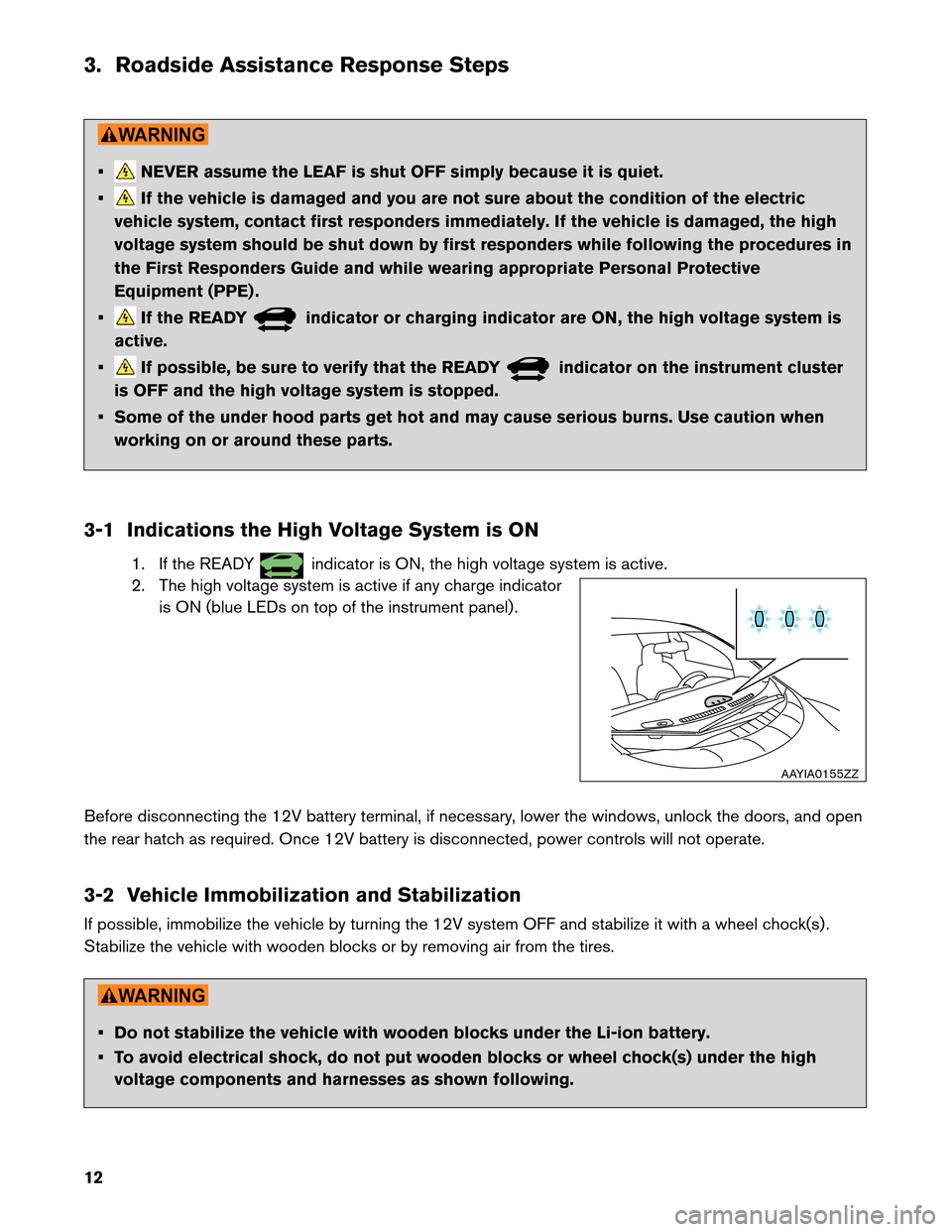
3. Roadside Assistance Response Steps
• NEVER assume the LEAF is shut OFF simply because it is quiet.
• If the vehicle is damaged and you are not sure about the condition of the electric
vehicle system, contact first responders immediately. If the vehicle is damaged, the high
voltage system should be shut down by first responders while following the procedures in
the First Responders Guide and while wearing appropriate Personal Protective
Equipment (PPE) .
• If the READY indicator or charging indicator are ON, the high voltage system is
active.
• If possible, be sure to verify that the READY indicator on the instrument cluster
is
OFF and the high voltage system is stopped.
• Some of the under hood parts get hot and may cause serious burns. Use caution when working on or around these parts.
3-1 Indications the High Voltage System is ON 1. If the READY indicator is ON, the high voltage system is active.
2.
The high voltage system is active if any charge indicator
is ON (blue LEDs on top of the instrument panel) .
Before disconnecting the 12V battery terminal, if necessary, lower the windows, unlock the doors, and open
the rear hatch as required. Once 12V battery is disconnected, power controls will not operate.
3-2 Vehicle Immobilization and Stabilization
If possible, immobilize the vehicle by turning the 12V system OFF and stabilize it with a wheel chock(s) .
Stabilize the vehicle with wooden blocks or by removing air from the tires. • Do not stabilize the vehicle with wooden blocks under the Li-ion battery.
•
To avoid electrical shock, do not put wooden blocks or wheel chock(s) under the high
voltage components and harnesses as shown following. AAYIA0155ZZ
12
Page 13 of 37
3-3 Turning OFF the Power Switch
1. Check the READY indicator status. If it is ON, the high voltage system is active.
2.
Press the power switch once to turn OFF the high
voltage system. Then verify whether the READY indicator is OFF. =
Li-ion battery
AAYIA0028GB AAYIA0091ZZ
13
Page 14 of 37
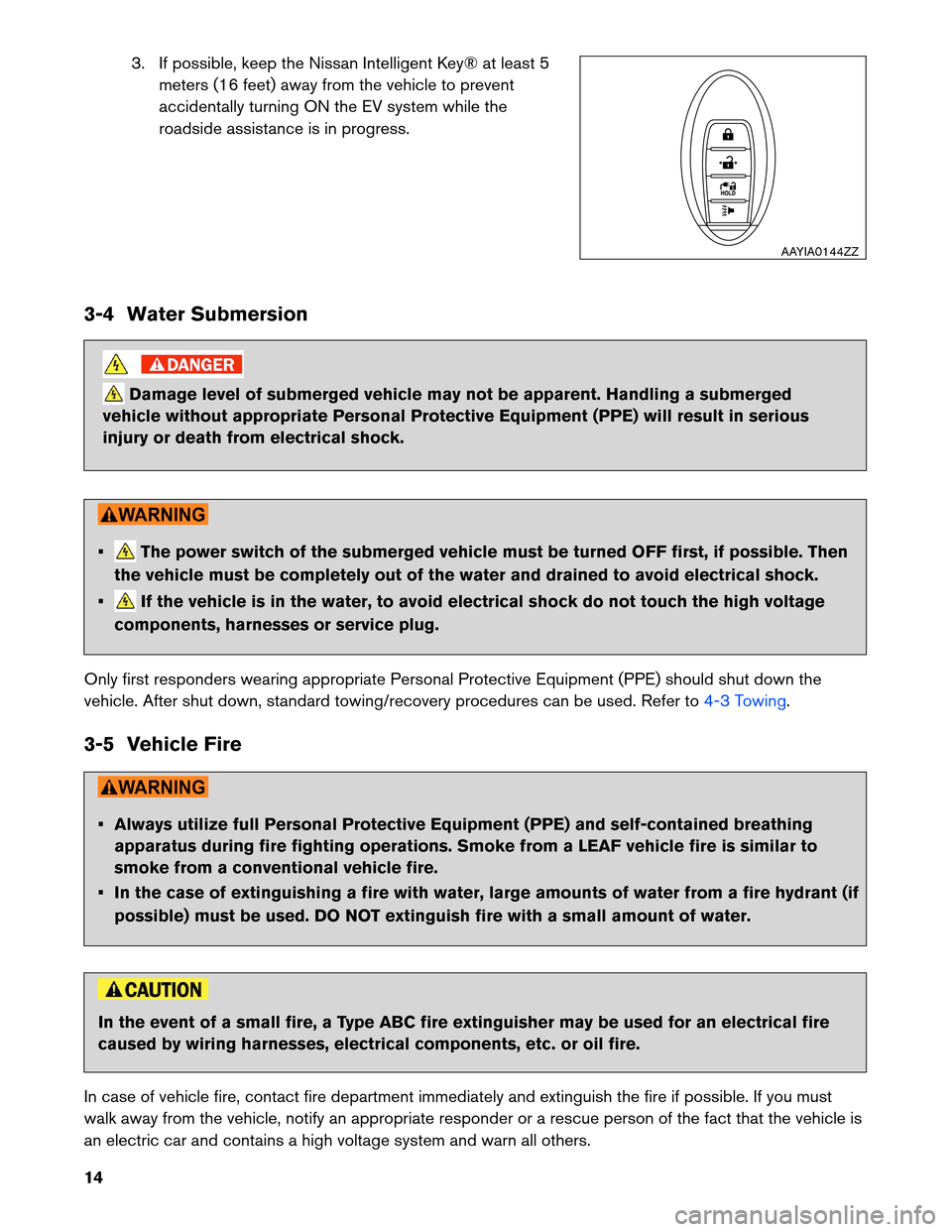
3. If possible, keep the Nissan Intelligent Key® at least 5
meters (16 feet) away from the vehicle to prevent
accidentally turning ON the EV system while the
roadside assistance is in progress.
3-4 Water Submersion Damage level of submerged vehicle may not be apparent. Handling a submerged
vehicle
without appropriate Personal Protective Equipment (PPE) will result in serious
injury or death from electrical shock. • The power switch of the submerged vehicle must be turned OFF first, if possible. Then
the
vehicle must be completely out of the water and drained to avoid electrical shock.
• If the vehicle is in the water, to avoid electrical shock do not touch the high voltage
components,
harnesses or service plug.
Only first responders wearing appropriate Personal Protective Equipment (PPE) should shut down the
vehicle. After shut down, standard towing/recovery procedures can be used. Refer to 4-3 Towing.
3-5
Vehicle Fire • Always utilize full Personal Protective Equipment (PPE) and self-contained breathing
apparatus
during fire fighting operations. Smoke from a LEAF vehicle fire is similar to
smoke from a conventional vehicle fire.
• In the case of extinguishing a fire with water, large amounts of water from a fire hydrant (if possible) must be used. DO NOT extinguish fire with a small amount of water. In the event of a small fire, a Type ABC fire extinguisher may be used for an electrical fire
caused
by wiring harnesses, electrical components, etc. or oil fire.
In case of vehicle fire, contact fire department immediately and extinguish the fire if possible. If you must
walk away from the vehicle, notify an appropriate responder or a rescue person of the fact that the vehicle is
an electric car and contains a high voltage system and warn all others.
HOLD AAYIA0144ZZ
14
Page 15 of 37
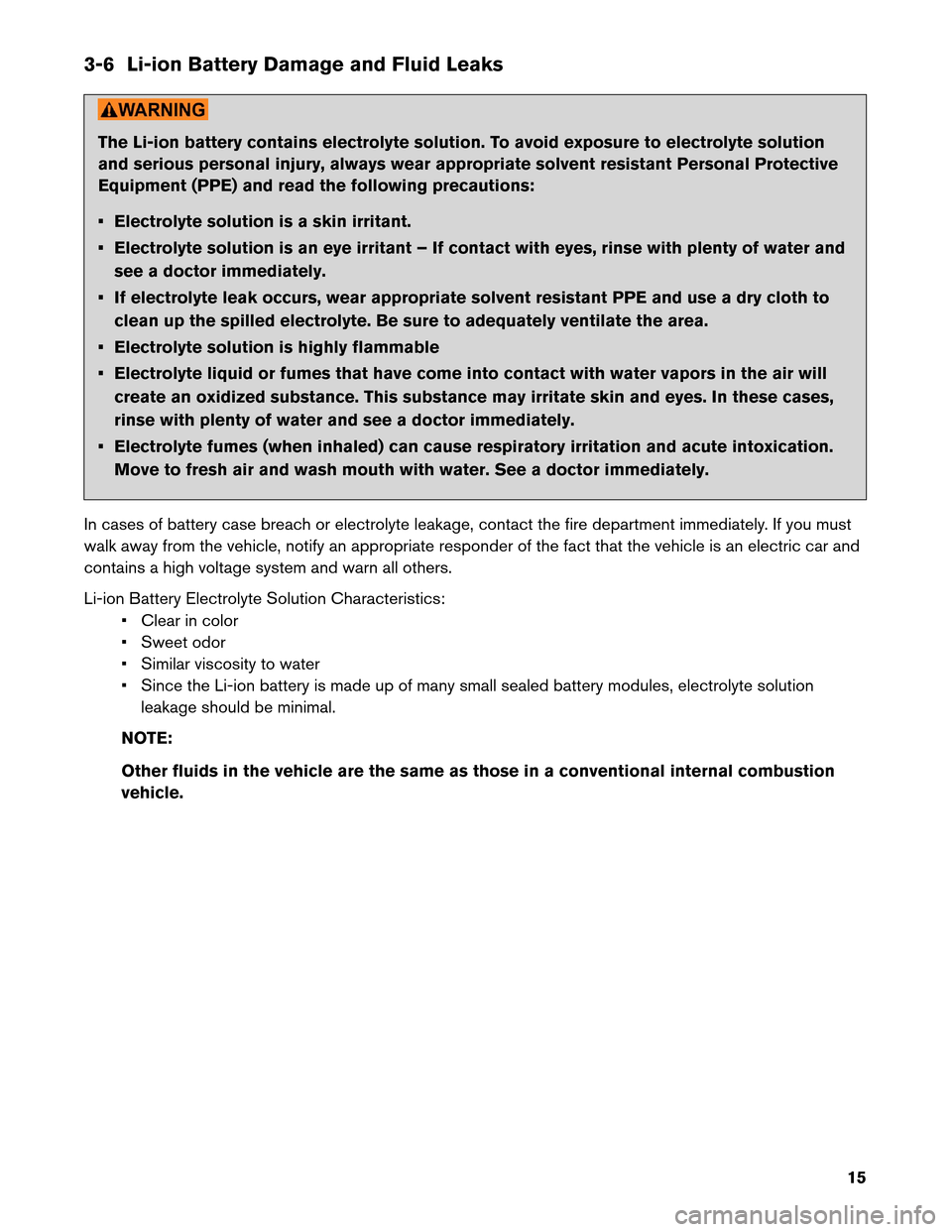
3-6 Li-ion Battery Damage and Fluid Leaks
The Li-ion battery contains electrolyte solution. To avoid exposure to electrolyte solution
and
serious personal injury, always wear appropriate solvent resistant Personal Protective
Equipment (PPE) and read the following precautions:
• Electrolyte solution is a skin irritant.
• Electrolyte solution is an eye irritant – If contact with eyes, rinse with plenty of water and
see a doctor immediately.
• If electrolyte leak occurs, wear appropriate solvent resistant PPE and use a dry cloth to clean up the spilled electrolyte. Be sure to adequately ventilate the area.
• Electrolyte solution is highly flammable
• Electrolyte liquid or fumes that have come into contact with water vapors in the air will create an oxidized substance. This substance may irritate skin and eyes. In these cases,
rinse with plenty of water and see a doctor immediately.
• Electrolyte fumes (when inhaled) can cause respiratory irritation and acute intoxication. Move to fresh air and wash mouth with water. See a doctor immediately.
In cases of battery case breach or electrolyte leakage, contact the fire department immediately. If you must
walk away from the vehicle, notify an appropriate responder of the fact that the vehicle is an electric car and
contains a high voltage system and warn all others.
Li-ion Battery Electrolyte Solution Characteristics: • Clear in color
• Sweet odor
• Similar viscosity to water
• Since the Li-ion battery is made up of many small sealed battery modules, electrolyte solutionleakage should be minimal.
NOTE:
Other fluids in the vehicle are the same as those in a conventional internal combustion
vehicle.
15
Page 16 of 37
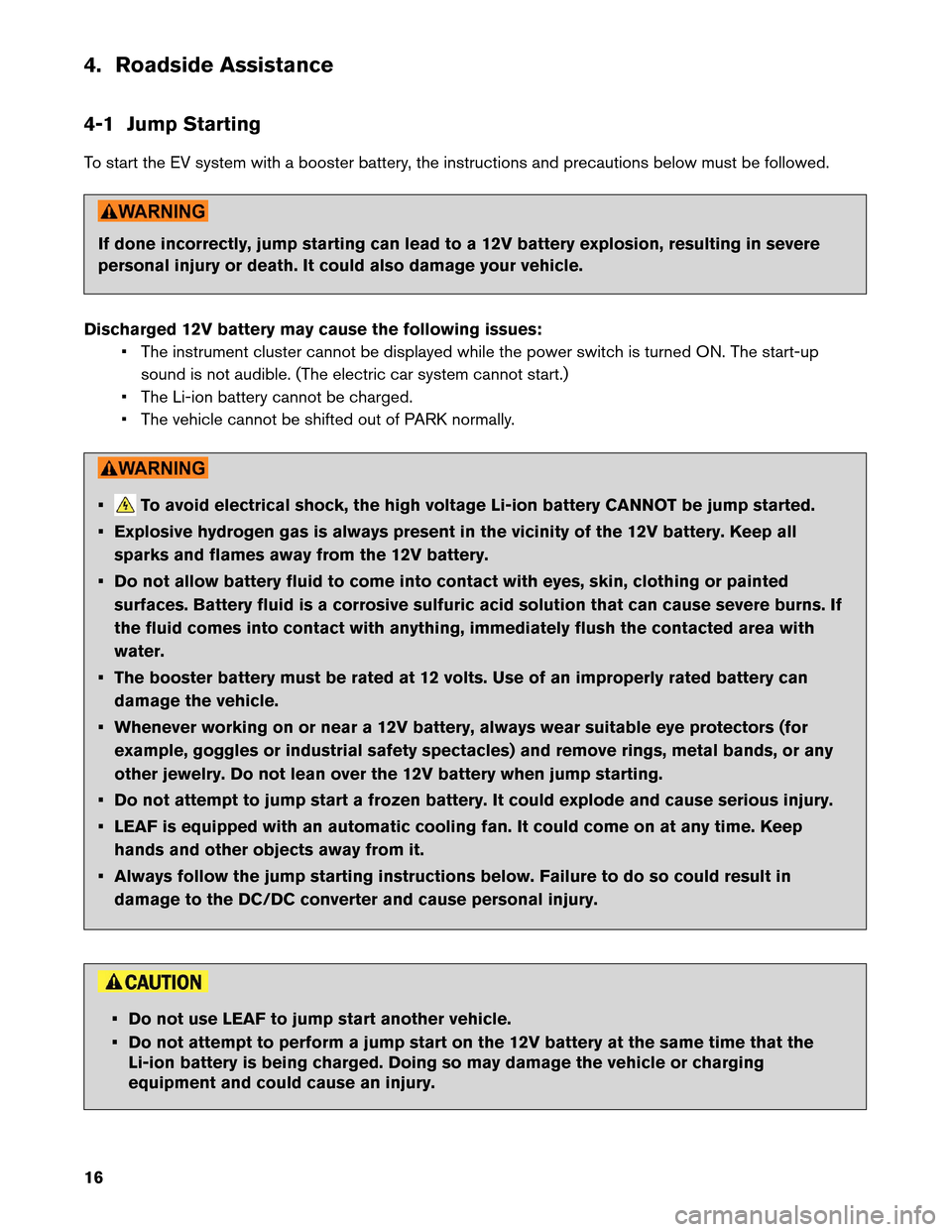
4. Roadside Assistance
4-1
Jump Starting
To start the EV system with a booster battery, the instructions and precautions below must be followed. If done incorrectly, jump starting can lead to a 12V battery explosion, resulting in severe
personal
injury or death. It could also damage your vehicle.
Discharged 12V battery may cause the following issues: • The instrument cluster cannot be displayed while the power switch is turned ON. The start-upsound is not audible. (The electric car system cannot start.)
• The Li-ion battery cannot be charged.
• The vehicle cannot be shifted out of PARK normally. • To avoid electrical shock, the high voltage Li-ion battery CANNOT be jump started.
•
Explosive hydrogen gas is always present in the vicinity of the 12V battery. Keep all
sparks and flames away from the 12V battery.
• Do not allow battery fluid to come into contact with eyes, skin, clothing or painted surfaces. Battery fluid is a corrosive sulfuric acid solution that can cause severe burns. If
the fluid comes into contact with anything, immediately flush the contacted area with
water.
• The booster battery must be rated at 12 volts. Use of an improperly rated battery can damage the vehicle.
• Whenever working on or near a 12V battery, always wear suitable eye protectors (for example, goggles or industrial safety spectacles) and remove rings, metal bands, or any
other jewelry. Do not lean over the 12V battery when jump starting.
• Do not attempt to jump start a frozen battery. It could explode and cause serious injury.
• LEAF is equipped with an automatic cooling fan. It could come on at any time. Keep hands and other objects away from it.
• Always follow the jump starting instructions below. Failure to do so could result in damage to the DC/DC converter and cause personal injury. • Do not use LEAF to jump start another vehicle.
•
Do not attempt to perform a jump start on the 12V battery at the same time that the
Li-ion battery is being charged. Doing so may damage the vehicle or charging
equipment and could cause an injury.
16